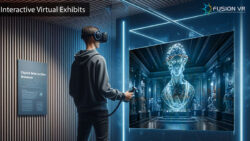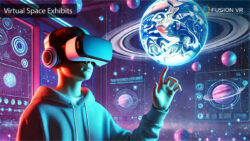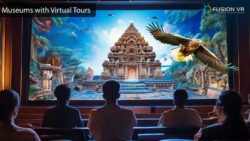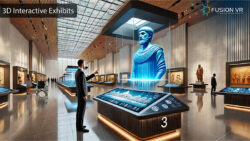Museums across the world remain one of the most important places that parents take their children to very early in their lives. The other place that ties with museums for that honor would be zoos. The question needs to be asked as to why parents typically do that across the world. Is this some kind of tradition or a cultural facet of parenting? The answer probably is that museums and zoos serve as places that offer vast opportunities and exposure to learn and gain useful knowledge for young minds. The see, experience and learn approach has worked well since we began building museums. The popularity of museums is also witnessed among tourists. Many of the world’s famous museums also serve as a magnet for tourists across the world. People flock to these museums to see the most amazing collection of cultural, historical and scientific artifacts of the world.
While the importance of museums is well understood, we have also noticed that the footfall in museums is seeing a decreasing trend. This trend is observed more in many of the traditional museums which have served mainly the purpose of preserving artifacts for future generations. They have done that amazingly well, but most visitors have seen that as a one-sided experience that is devoid of much interaction. The generations that have grown up or were born with the digital lifestyle are expecting more interactive experiences wherever they go and in whatever they do. They are expecting to be engaged instantly and entertained memorably. The rise of electronic entertainment through gaming has influenced the younger generation for similar experiences. There is a need to address this to make traditional museums move towards incorporating digital interactive experiences in all their offerings. Corporate entities have begun to value their journey towards success and are interested in creating their own museums and experience centers.
The future of museums is briskly moving towards the increased deployment of interactive and immersive experiences with and without the explicit involvement of existing museum artifacts. It is understandable that involving the direct use of valuable and rare exhibits requires extreme care and maintenance. These interactive and immersive experiences of the future require the expert use of augmented reality (AR) and virtual reality (VR) technologies in addition to highly sophisticated digital hardware and equipment. In fact, it is these technologies that will help to preserve precious artifacts that could deteriorate at a faster pace due to exposure to human and environmental factors. The beauty and awesomeness of these artifacts can still be delivered to visitors using VR and AR. There are several museums across the world that have begun to use these technologies in museums as they deliver some of the most magical experiences.
Museum experiences in the future will see an increase in virtual reality time travel experiences. Several of the wonders of the world have been lost to climatic deterioration and destruction. More worrisome is the valuable cultural treasures lost to human-led destruction through war or ideological differences. The Buddhist sculptures of Bamiyan in Afghanistan are one example of a valuable cultural treasure that will be lost to the ages. It is conceivable that the sculpture is recreated digitally and a virtual reality travel to witness is created. This experience will recreate the landscape in Bamiyan and enable the visitors to navigate in VR to witness the glory of the art that was created many centuries ago. This time travel experience helps to experience the beauty and learn more about the making and destruction of those artifacts. VR experiences can be overlaid with information and accompanied with voice-over instructions and information to enrich the overall experience. A virtual guide helps the visitor navigate and pay attention to finer details that might otherwise go unnoticed.
While time travel requires the digital recreation of historical artifacts and locations, there are many existing cultural experiences that are simply not accessible to the general public. These are either expensive or completely unsafe to visit. The question therefore is how do we get to experience those wonders without much risk? Virtual tours are developed that capture these wonderful places for a VR experience that is made available to museum visitors. VR clips of a walk in the Amazon, a climb up the Everest, or a dive into the Great Barrier Reef is eminently possible in virtual reality. The virtual reality environment effectively tricks the human mind into believing that it is in that reality and delivers the magic and wonder that a person would directly experience in a real environment. These experiences are expertly arranged for visitors of all ages to experience it and also learn more about it in a VR experience center.
Museums will no longer remain as places where valuable artifacts are preserved for the benefit of future generations. It would transform itself into places of interaction, engagement and enjoyment. They would also become places of learning and enable collaboration between museums and institutions to maximize the effectiveness of a learning program. Integration of museum-based learning into an existing academic curriculum promotes a better appreciation of the subject matter and retention of what is taught. Virtual Reality and Augmented reality both play a wonderful role in this effort
Augmented reality could usher in a future where we need not rely on experienced guides to explore a museum. All the expertise of museum curators, historians, scientists and other professionals will be contained inside an AR application and presented as you step into a museum. The application loaded onto your smartphone becomes your very own personalized museum guide. You not only find that free, but all released from the prescribed tour established by your guide. That tour could possibly be limited by the physical and knowledge boundaries of that particular guide. Now, you design and customize your own experience with your augmented reality museum guide.
If your interest is only in exploring the art collections, you could indicate your preferences and hit go. The smartphone application opens up your device camera and guides you to the desired area of the museum. The application would have directions overlaid on what you see and take you there. Voice-activated guidance is also made available. The application provides information about the most interesting or more recent art collections available in the museum based on your selection. Viewing a painting or sculpture activates digital content on your smartphone. This content is overlaid and provides information as text, video or animation about the artifact. Details of the various features, its provenance, the creator’s efforts, materials and much more is delivered in an instant. The app would also feature a 3D model of the artifact allowing the visitor to rotate and view it from all angles and gain a deeper appreciation of it. The model could be animated to provide an exploded or X-ray view of the same delivering greater details of its construction. These are experiences that can never be provided by a physical guide with a dozen or more visitors in tow around a museum. These limitations are overcome by technologies such as augmented reality. The effort required to deliver such experiences is significant as it needs a clear vision from the museum leadership and the collaboration of experts forming a cross-functional team. Their efforts are critical to a successful AR VR museum experience. This includes expert service providers of Museum 2.0 solutions who help integrate and transform traditional museums into immersive and interactive museums.
There is not much effort needed to find such a partner who can handhold your museum team to deliver exciting experiences for an AR VR Museum. Fusion VR is not only a pioneer but also one of the leaders in delivering museum experiences in India. Our expertise is not only with museums but also with corporate experience centers. Our recent projects such as the Amma Museum and Kalaignar Museum in Chennai and a bag of other projects in the pipeline are a testament to our capabilities. We encourage you to visit our website or pick up the phone and give us a call.





